Growing soybean in Victoria
The Soybean (Glycine max) is an irrigated summer growing oilseed crop whose grain in Australia has traditionally been used for oil extraction and the meal used in the stockfeed industries. More recently soybeans have become a popular culinary grain used in the making of Asian foodstuffs such as milk and tofu.
Australia and Victoria are net importers of soybeans for animal rations where this competes with domestic canola meal. Soybeans were first grown in Victoria in the early 1980s.
The aims of the current breeding program are to develop varieties that are:
- better suited to culinary uses
- adapted to growing in southern regions
- resistant to phytophthora root rot disease
Highest prices are obtained for export grade soybeans for Japan, capable of filling an out of season supply from the Northern Hemisphere.
Best time to sow soybean
Soybeans are best suited to the northern irrigation areas of Victoria where summer temperatures are warm and day length is longer.
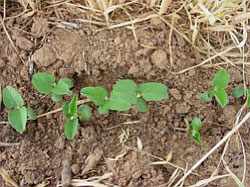
In tropical areas of Australia they can be grown on stored and summer rainfall but southern Australia is too dry for this to be considered.
Soybeans are a very photo-period sensitive plant, meaning the trigger to start flowering is brought on by the decreasing day length after the summer solstice on 22 December. In southern latitude climates such as Victoria it is important to maximise vegetative growth before this period to maximise yield.
Experience has shown that there is little value in very early sowing and that 15 November is an optimum date in most years.
Sowing too late leads to a crop unable to reach:
- optimum vegetative growth
- low pods
- lengthens the maturity time into late April or May
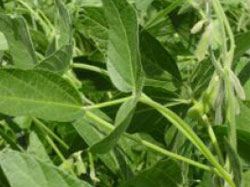
Lengthening the maturity time can increase the risk of:
- weather damage
- late harvest
- small immature seed
- reduced time available for winter crop planting
Varieties grown in Victoria have an indeterminate growth habit. Flowering starts 50 to 60 days after sowing (20 to 35cm height) and continues through to between 80 to 120cm. The crop reaches physiological maturity 140 days after sowing.
Soil type

Soybeans have been successfully grown on many irrigated soil types, using:
- border-check flood
- overhead sprinkler
- bed layouts
Soybeans have little tolerance to waterlogging up until the 4 leaf stage so a laser graded layout capable of rapid watering and drainage is essential. Aim to have water on and then off within 12 to 18 hours.
Mature plants have greater waterlogging tolerance and occasional periods less than 48 hours can cause minimal yield loss.
Soybeans are intolerant of soil salinity and need soil with less than 2dS per metre ECe and irrigation water needs to be less than 1.5 dS per metre ECw. Paddocks with a pH (CaCl2) of less than 4.8 may need liming, soybeans are intolerant of acidity.
Soybean seeding
Soybean seed is very fragile and cannot cope with seed coat damage.
The use of spiral augers is not recommended. Belt shifters or vacuums are much gentler on seed.
Even though beans should be harvested at 15% moisture content to minimise seed damage, the seed should be stored at below 13% and preferably at 10% moisture content and kept cool to maintain viability. Regardless of this though, soybean seed loses viability quickly and a germination test as close as possible to sowing is essential.
Sowing two-year old seed is not recommended and fresh seed, every year is the best option.
Crop establishment
Crop establishment is the biggest variable and is best known from experience using your sowing equipment and farming system.
Establishment problems can be down to:
- poor vigour seed
- sowing depth
- high or low seedbed moisture
- crusting
Low plant numbers lead to pods formed low to the ground, whereas high plant numbers lead to tall plants prone to lodging. Growers with open front headers claim that this is not a major impediment to harvest as they harvest the whole crop low anyway. High plant numbers can also increase the severity of Sclerotinia root rot if it attacks the crop.
Management practices
Inoculation
Soybeans have a large requirement for nitrogen, but can obtain the majority of this from the air via Rhizobium bacteria forming nodules on their root system. Soybean seed needs to be inoculated with group H rhizobia to get effective nodulation and ensure adequate nitrogen nutrition to the plant. Rhizobium bacteria need low nitrogen soils for optimum effectiveness and soybeans grown after cereal crops rather than pasture provide these conditions.
Fertilisers
Soybeans are large users of soil nutrients. In a properly nodulated crop up to 100kg of nutrient per hectare will be produced for every tonne of grain produced.
Soybeans have a large requirement for phosphorous. For every tonne of grain produced the crop will take up 11kg of phosphorous per hectare and the grain will remove 7kg of phosphorous per hectare. Soybeans have an extended period of phosphorous uptake right up until mid pod-fill. High fertility paddocks may be better at providing extended phosphorous availability, rather than extra large doses of starter phosphorous fertiliser. Rates in the range from 24 to 40kg per hectare of phosphorous are regularly used.
Sulphur is not likely to be a problem on soils that have seen single superphosphate application or where gypsum has been applied.
Potassium is usually plentiful in northern Victorian soils but may need close monitoring if many hay and silage crops have been removed.
Molybdenum could be deficient in acid topsoils but addition of lime to correct the pH above 4.8 CaCl2 is more beneficial.
Zinc could be deficient in some highly alkaline grey or black clay soils.
Sowing
Soybeans can be sown on stored moisture and after rainfall but it is rare that this is possible. Soybeans must be pre-watered to ensure successful establishment and good nodulation. After watering, the crop is sown into receding soil moisture approximately 8 to 15 days afterwards depending on seasonal and soil conditions. Pre-watering early in November will lead to sowing at around the optimum time. The soil temperature needs to be above 13o for successful germination but above 25o is optimum for rapid emergence.
Sowing depth is important for good establishment, too shallow will lead to desiccation of the seed but too deep can mean seedlings fail to emerge, 5cm is usually optimal. Full cultivation and incorporation of pre-emergent herbicides before sowing has been practised, but modern direct drill machines with press wheels or harrows have enabled one pass sowing and incorporation with successful crop emergence.
On many soil types, rainfall after sowing can lead to crusting and emergence problems, use of high rates of gypsum can help to alleviate this problem. Watering up dry-sown beans is not recommended on most soil types because of crusting. Recently laser graded paddocks are not recommended, as soybeans are a poor pioneering crop. The crop can live on pre-watered moisture for some time before the first irrigation and will usually be about 20cm high. After this time more rapid plant growth leads to a higher water demand and irrigation every 10 to 14 days will be required.
Watering
When the crop has full ground cover and pod fill has just started watering may need to be brought to a tighter 7 day schedule. Watering intensity is usually tapered off towards the end of the crops' growth.
Many growers avoid late irrigation for fear of an early break to the season making harvest difficult. However, water stress at the final stages of pod fill can be costly to yield. Try to keep moisture availability up until 50% of pods have reached physiological maturity (yellowing pods and leaf drop).
Tensiometers are a good way of monitoring soil moisture especially in the later stages of growth. They allow greater confidence in what water is available to the crop and give the ability to water when the crop actually needs it. Soybeans are a relatively low water use crop. Depending on season and soil type, irrigation water use varies between 4.5 to 8.5 ML per hectare, the average is around 6.5 ML per hectare.
Sowing rates
Sowing rates for soybeans need to be adjusted for seed size and germination % every year to achieve a density of 3035 plants per metre (m2). Seed size between varieties and between paddocks of the same variety can differ remarkably.
Stephens beans can have seed as small as 14g per 100 seeds where large culinary grade beans could be 24g per 100 seeds, 70% larger, necessitating a corresponding increase in seeding rate to achieve the same plant density.
The following formulae can be used to calculate the required sowing rate:
Seeding rate (kg/ha) = Required Plant density/m2 × 100 seed weight in grams × 1000 Germination % × Establishment %
Controlling weeds
Soybeans are a very vigorous crop that can out compete many weeds if they can achieve full canopy coverage of the ground early. Narrow sowing rows and early sowing can help to achieve this quickest. Early weed control is best for highest yields, as bean seedlings are at their most vulnerable between 4 to 7 weeks from sowing.
Choice of a low weed background paddock that has been in rotation with other winter and summer crops helps.
Use of pre-emergent herbicides against hogweed and other grasses is recommended initially followed up by post-emergent weed control at an early growth stage if required. Broadleaf weeds such as Bathurst Burr and Black Berry Nightshade are competitors and seed quality contaminants, while grass weeds such as Barnyard Grass thrive in wet conditions and are highly competitive. Weeds at crop maturity can delay harvest and block machinery and are best desiccated 1 to 2 weeks before harvest.
Diseases
There are few fungal diseases that affect soybeans in Northern Victoria. Phytophthora root rot is the major one since its re-discovery in 2002. This fungus was identified to be race 15, a common race in NSW. While most of the varieties have resistance or field tolerance to race 15 and other races, there is a need to be vigilant and to monitor the progress of this disease. The disease is favoured by wet and waterlogged conditions and is best identified at the bottom of bays. The disease leads to a brown or dead tissue lesion emanating from the ground and up the stem. The fungus effectively prevents water uptake by the plant and a major symptom is wilting and dead plants in the presence of living ones, dead patches can sometimes occur.
Sometimes the fungus Sclerotinia attacks soybeans, leading to isolated dead plants that sometimes develop to patches. Warm humid weather favours the disease and plants can be identified by having white fungal growth on the outside of stems and black sclerotes (looking like rat droppings) on the inside of the stems. Sclerotinia is an insidious disease that is difficult to control and lasts for long periods in the soil.
Insects
The soybean plant is vulnerable to insect attack over the whole of its growing period.
In early seedling development the grubs of the Common Grass Blue Butterfly(GBB) and Soybean Moth can cause extensive foliar damage. At later stages GBB can destroy buds, flowers and eat developing seeds.
During early pod formation the Green Mirid can cause abortion of pods and individual seeds in pods.
Throughout the whole of podding, Green Vegetable and Red Banded Shield bugs, Bean bugs and Brown Stink Bugs can cause severe losses of pods and seeds as well as causing seed discolouration, distortion and yield loss.
Helicoverpa grubs can cause severe damage to developing pods and seeds and usually arrive at the mid to late pod filling stage.
Harvesting soybean
Soybean seed is accepted by buyers at 15% to 13% moisture on an oven dry basis but only if the seed falls out of the testing cup after being squashed tight. The optimal moisture level for harvest is 13% as lower levels can lead to pod shattering and cracking and splitting of seed.
Harvesting often starts at 12pm when the dew has dried off, until 5pm when it sets in again and the plants and seeds take up moisture. Harvesting in the early morning or evening may be required if the moisture content is too low during the day.
The use of desiccant herbicide to mature the crop evenly, dry off weeds and reduce seed moisture content is recommended in some seasons, and is probably good insurance in most. The crop is ready for desiccation when the plant has reached physiological maturity, this is when the pods are yellow and the leaves are yellow and falling off. Desiccating too early can be detrimental to yield. Harvest with an open front header held low to get the bottom pods. The concave should be open, drum speed low and wind high to minimise seed damage and maximise sample purity.
After harvest and depending on the season, some growers are making good money from baled soybean stubble, which is sold to the livestock industry or for garden mulch.
Soybean varieties
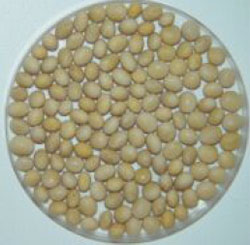
Snowy (97016-11)
Snowy, bred by Andrew James and selected by Luke Gaynor and released in 2005, is a couple of days later than Empyle but significantly earlier than Bowyer and Curringa. It has a clear hilum, good seed size, protein and excellent tofu making ability.
Djakal (BAF212)
Djakal, bred by Ian Rose, selected by Judith Andrews and released in 2001, is similar to slightly earlier in maturity compared to Stephens. It has a buff and brown hilum and good seed size suitable for the culinary market. Djakal has good lodging resistance but has a tendency for lower protein content. Djakal is the highest and most consistent yielder available to date.
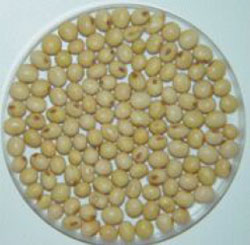
Empyle (TH247)
Empyle was bred by Ken McWhirter and released in 2001. It is a buff and brown hilum bean suitable for the culinary market. Empyle has good lodging resistance under high yielding conditions but has a tendency for small seed size.
Empyle's maturity is a few days later than Stephens. Empyle requires a growing agreement including royalty to the breeder.
Naring (WNC133)
This variety was bred by Ian Rose, selected by Ken Pritchard and released in 2000. It has a small yield advantage over Stephens. It has better lodging resistance and a similar maturity to Stephens. It has a black hilum and is a crushing quality bean.
Curringa (DHF064)
Curringa was bred by Ian Rose, selected by Judith Andrews and released in 1999, being very similar in growth and seed type to Bowyer, it has increased yield, disease and lodging resistance compared to Bowyer. Likewise to Bowyer, its maturity is too late for reliable growing in Northern Victoria.
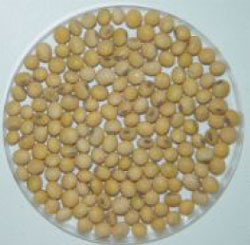
Stephens
This variety was bred by Ken McWhirter, released in 1987 and is the standard variety for maturity length in Victoria. Stephens is a crushing quality bean with a grey hilum. It has poor lodging resistance but has been a proven high yielding variety over many years.
Bowyer
Bowyer was bred by Ken McWhirter and released in 1982, it has been a high quality culinary bean for some time. It has good seed size, protein content and has a brown and buff hilum. Its maturity is at least a week to two weeks later than Stephens and for this reason cannot be recommended for Northern Victorian seasonal conditions.
Table 1 — Yield of soybeans over 10 seasons 1993 to 2005 Victorian trials
Bowyer
| Year | Grain yield (t/ha) |
|---|---|
| 1993 to 1994 | 1.95 |
| 1994 to 1995 | 3.73 |
| 1995 to 1996 | 2.05 |
| 1996 to 1997 | 1.50 |
| 1997 to 1998 | 2.40 |
| 2000 to 2001 | 2.98 |
| 2001 to 2002 — pre release trial | 2.71 |
| 2001 to 2002 — advanced trial | 1.90 |
| 2002 to 2003 | 3.95 |
| 2003 to 2004 | — |
| 2004 to 2005 | — |
| Average | 2.57 |
Curringa
| Year | Grain yield (t/ha) |
|---|---|
| 1993 to 1994 | — |
| 1994 to 1995 | 4.13 |
| 1995 to 1996 | 2.54 |
| 1996 to 1997 | 1.57 |
| 1997 to 1998 | 2.72 |
| 2000 to 2001 | 2.53 |
| 2001 to 2002 — pre release trial | 2.84 |
| 2001 to 2002 — advanced trial | 2.60 |
| 2002 to 2003 | — |
| 2003 to 2004 | 1.20 |
| 2004 to 2005 | 3.01 |
| Average | 2.57 |
Djakal
| Year | Grain yield (t/ha) |
|---|---|
| 1993 to 1994 | — |
| 1994 to 1995 | — |
| 1995 to 1996 | — |
| 1996 to 1997 | — |
| 1997 to 1998 | — |
| 2000 to 2001 | 2.91 |
| 2001 to 2002 — pre release trial | 3.13 |
| 2001 to 2002 — advanced trial | 3.01 |
| 2002 to 2003 | 3.94 |
| 2003 to 2004 | 3.09 |
| 2004 to 2005 | 3.28 |
| Average | 3.23 |
Empyle
| Year | Grain yield (t/ha) |
|---|---|
| 1993 to 1994 | — |
| 1994 to 1995 | — |
| 1995 to 1996 | — |
| 1996 to 1997 | — |
| 1997 to 1998 | — |
| 2000 to 2001 | — |
| 2001 to 2002 — pre release trial | 2 |
| 2001 to 2002 — advanced trial | 2.66 |
| 2002 to 2003 | 4.58 |
| 2003 to 2004 | 2.74 |
| 2004 to 2005 | 3.32 |
| Average | 3.06 |
Naring
| Year | Grain yield (t/ha) |
|---|---|
| 1993 to 1994 | 2.74 |
| 1994 to 1995 | 5.08 |
| 1995 to 1996 | 3.76 |
| 1996 to 1997 | 3.54 |
| 1997 to 1998 | 2.64 |
| 2000 to 2001 | — |
| 2001 to 2002 — pre release trial | — |
| 2001 to 2002 — advanced trial | — |
| 2002 to 2003 | 3.87 |
| 2003 to 2004 | — |
| 2004 to 2005 | — |
| Average | 3.61 |
Snowy
| Year | Grain yield (t/ha) |
|---|---|
| 1993 to 1994 | — |
| 1994 to 1995 | — |
| 1995 to 1996 | — |
| 1996 to 1997 | — |
| 1997 to 1998 | — |
| 2000 to 2001 | — |
| 2001 to 2002 — pre release trial | — |
| 2001 to 2002 — advanced trial | — |
| 2002 to 2003 | 4.81 |
| 2003 to 2004 | 2.18 |
| 2004 to 2005 | 2.92 |
| Average | 3.30 |
Stephens
| Year | Grain yield (t/ha) |
|---|---|
| 1993 to 1994 | 2.72 |
| 1994 to 1995 | 4.49 |
| 1995 to 1996 | 3.80 |
| 1996 to 1997 | 3.34 |
| 1997 to 1998 | 2.72 |
| 2000 to 2001 | 2.51 |
| 2001 to 2002 — pre release trial | 2.98 |
| 2001 to 2002 — advanced trial | 3.09 |
| 2002 to 2003 | 3.71 |
| 2003 to 2004 | 1.63 |
| 2004 to 2005 | 1.82 |
| Average | 2.98 |
Key tips for success
- Drainage — Ensure layout allows irrigation and drainage within eight hours.
- Soil structure — Good soil structure.
- Sub-soil moisture — Use pre-irrigation to achieve adequate soil moisture at sowing.
- Sown on time — Sow recommended varieties within the preferred sowing window for your location.
- Crop establishment — Aim at a plant population of 35 to 40 plants per square metre.
- Adequate nutrition — Apply P according to paddock history, soil test results and target yield removal figures. Approximately 40 kg P per hectare is required by a four-tonne crop. Inoculate seed with appropriate rhizobium to meet N requirements of soybeans.
- Control weeds, pests and diseases — Use pre and post emergent herbicides and pesticides to ensure minimal yield loss. Check constantly for insects from emergence to maturity.
- Soil moisture — Check to ensure timely irrigation. Ensure plants have adequate available water for the entire growing season.
- Harvest — Desiccants can be useful for an early harvest and to achieve a quality high yielding crop.